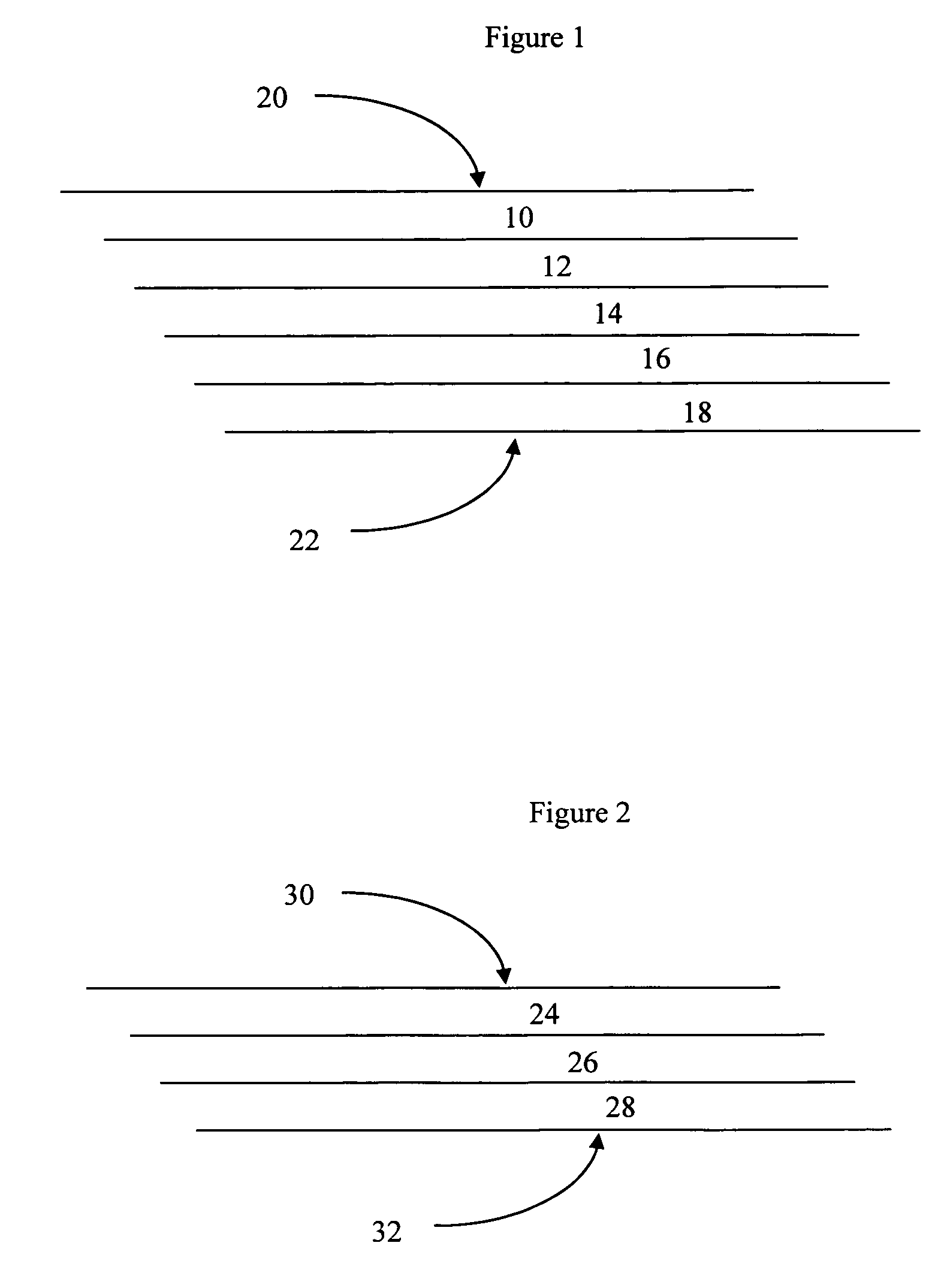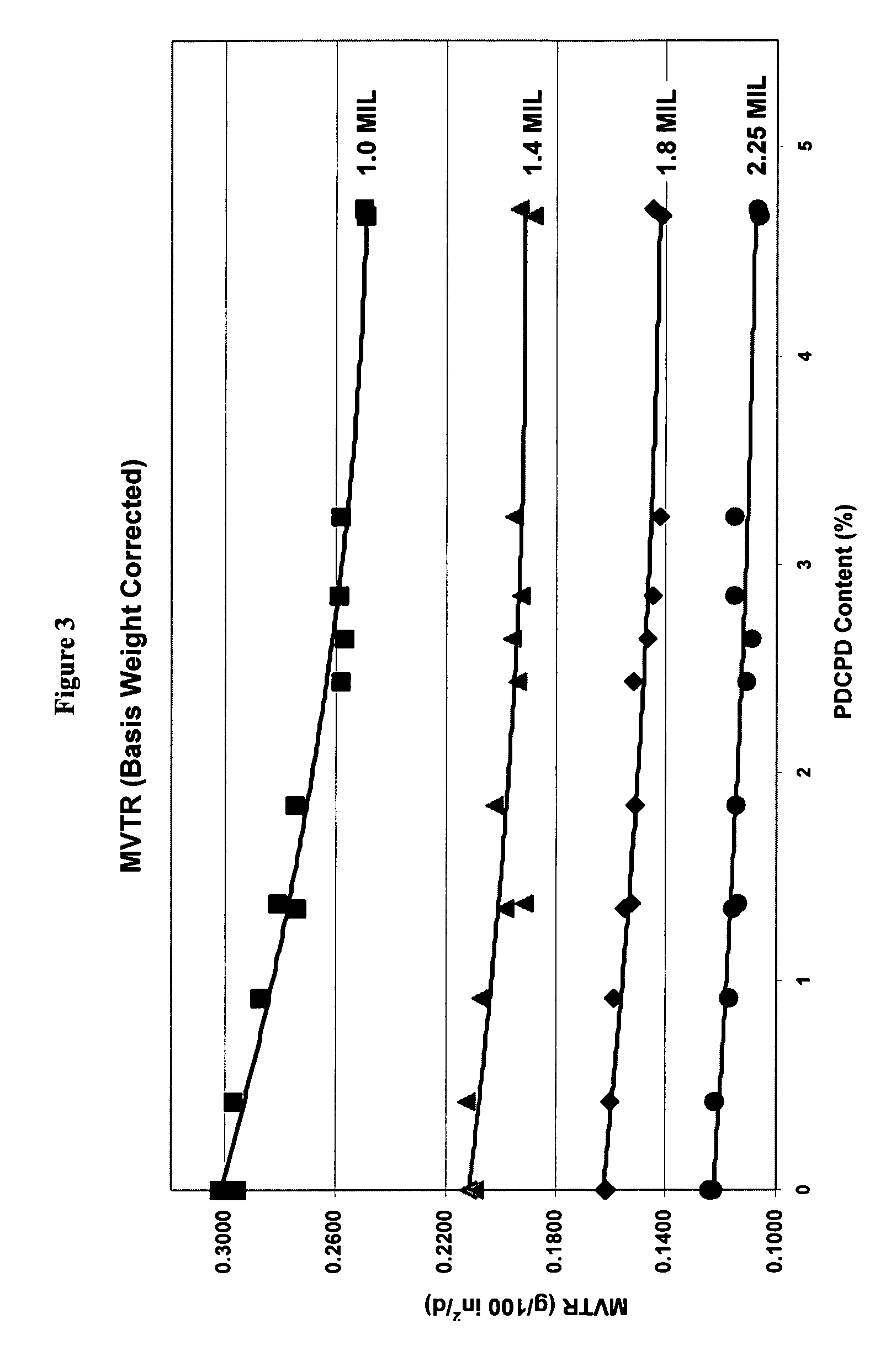Polyethylene/low molecular weight hydrogenated aliphatic resin blends
- Summary
- Abstract
- Description
- Claims
- Application Information
AI Technical Summary
Benefits of technology
Problems solved by technology
Method used
Image
Examples
example 1
Evaluation of the Effect on the Moisture Vapor Transmission Rate of Blending Masterbatch Poly(Dicyclopentadiene) with HiD 9659 HDPE at Low Wt %
[0059]Hydrogenated PDCPD in masterbatch form (50 wt % HDPE and 50 wt % hydrogenated PDCPD) was dry blended into HiD 9659 at concentrations of 1 wt % (Blend 1) and 5 wt % (Blend 2). These addition rates of the masterbatch were equivalent to an effective addition of 0.5% and 2.5% of raw hydrogenated PDCPD.
[0060]
TABLE 1ResinHiD 9659Blend 1Blend 2Masterbatch Addition1% 5% Active Ingredient0.50%2.50%(PDCPD)Incorporation MethodMB / MB / Dry-Dry-blendblendBasis Weight Gaugemils1.121.141.19MVTR (Raw)g / 100 in2 / d0.2690.2490.217nMVTRg-mils / 100 in2 / d0.3010.2830.258MVTR Improvement5.914.2Raw OTRcc / 100 in2 / d125116105nOTRcc-mils / 100 in2 / d140132125OTR Improvement%5.510.8
[0061]The HiD 9659 HDPE / hydrogenated PDCPD (MB) blends having 0.5 to about 2.5 wt % of hydrogenated PDCPD had improved (e.g. reduced) moisture vapor transmission rates (MVTRs) and oxygen transm...
example 2
Evaluation of the Effect on the Moisture Vapor Transmission Rate Of Blending Masterbatch Poly(Dicyclopentadiene) with Resin Y at Low Wt %
[0062]MB was dry blended into Resin Y at 1, 5 and 10 wt %. These addition rates of the masterbatch were equivalent to an effective addition of 0.5, 2.5 and 5 wt % of raw hydrogenated PDCPD.
In addition to the dry blend addition of MB to Resin Y, a second set of samples were evaluated in which MB was melt blended into Resin Y fluff at a 5 wt % level (equivalent to 2.5 wt % hydrogenated PDCPD).
[0063]
TABLE 2SAMPLEResin YBlend 1Blend 2Blend 3C5H-0102C5H-0103BaseResin Y BaseResin Y BaseMasterbatch Addition%015105PDCPD Concentration%0.52.552.5Incorporation MethodMB / DryblendMB / DryblendMB / DryblendMB / Com-poundedFILM PROPERTIES(1.35 mil)1% Secant ModulusMDpsi161300153400145500146600154500142800TDpsi205900196000181800185500199000174100Tear StrengthMDg / mil15.615.815.514.115.417TDg / mil792850340200850457BARRIERPROPERTIESMVTR0.90 MIL FILMBasis Weight Gaugemils0.91...
example 3
Evaluation of the Effect on the Moisture Vapor Transmission Rate of Blending Masterbatch Poly(Dicyclopentadiene) with Resin Y and Resin Z HDPE at Low Wt %
[0065]1 and 5 wt % of MB (equivalent of 0.5 and 2.5 wt % hydrogenated raw PDCPD) were dry blended into the two HDPE resins, Resin Y and Resin Z. The blend was used in preparing blown films.
[0066]
TABLE 3RESINResin YBlend 1Blend 2Resin ZBlend ABlend BDescriptionControlControlMasterbatch Addition%015015PDCPD Concentration%00.52.500.52.5Incorporation MethodMB / DryblendMB / DryblendMB / DryblendMB / DryblendRESIN PROPERTIESHexane Extractables%0.691.342.980.381.052.82Xylene Extractables%0.921.523.050.521.062.81FILM PROPERTIESElmendorf Tear (0.90 mils)MDg / mil212219293041TDg / mil84666071811601380800Elmendorf Tear (1.25 mils)MDg / mil201715212225TDg / mil54242364810989941054Elmendorf Tear (1.75 mils)MDg / mil161515182017TDg / mil7126892607547144311% Secant ModulusMDpsi154100144800139600141400135200130800TDpsi205500193900187200203100195100182200BARRIER PROP...
PUM
| Property | Measurement | Unit |
|---|---|---|
| Density | aaaaa | aaaaa |
| Molar mass | aaaaa | aaaaa |
Abstract
Description
Claims
Application Information
 Login to View More
Login to View More - R&D
- Intellectual Property
- Life Sciences
- Materials
- Tech Scout
- Unparalleled Data Quality
- Higher Quality Content
- 60% Fewer Hallucinations
Browse by: Latest US Patents, China's latest patents, Technical Efficacy Thesaurus, Application Domain, Technology Topic, Popular Technical Reports.
© 2025 PatSnap. All rights reserved.Legal|Privacy policy|Modern Slavery Act Transparency Statement|Sitemap|About US| Contact US: help@patsnap.com



